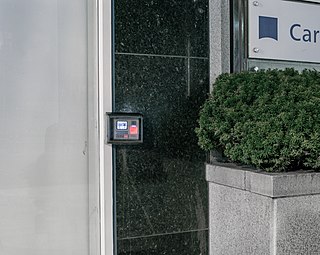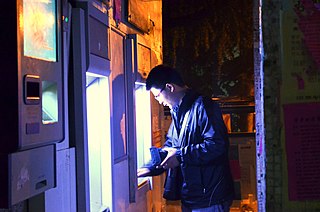
In physical security and information security, access control (AC) is the selective restriction of access to a place or other resource, while access management describes the process. The act of accessing may mean consuming, entering, or using. Permission to access a resource is called authorization.
An authenticator is a means used to confirm a user's identity, that is, to perform digital authentication. A person authenticates to a computer system or application by demonstrating that he or she has possession and control of an authenticator. In the simplest case, the authenticator is a common password.

Authentication is the act of proving an assertion, such as the identity of a computer system user. In contrast with identification, the act of indicating a person or thing's identity, authentication is the process of verifying that identity. It might involve validating personal identity documents, verifying the authenticity of a website with a digital certificate, determining the age of an artifact by carbon dating, or ensuring that a product or document is not counterfeit.
Biometrics are body measurements and calculations related to human characteristics. Biometric authentication is used in computer science as a form of identification and access control. It is also used to identify individuals in groups that are under surveillance.
An authentication protocol is a type of computer communications protocol or cryptographic protocol specifically designed for transfer of authentication data between two entities. It allows the receiving entity to authenticate the connecting entity as well as authenticate itself to the connecting entity by declaring the type of information needed for authentication as well as syntax. It is the most important layer of protection needed for secure communication within computer networks.
Internet security is a branch of computer security. It encompasses the Internet, browser security, web site security, and network security as it applies to other applications or operating systems as a whole. Its objective is to establish rules and measures to use against attacks over the Internet. The Internet is an inherently insecure channel for information exchange, with high risk of intrusion or fraud, such as phishing, online viruses, trojans, ransomware and worms.
Identity management (IdM), also known as identity and access management, is a framework of policies and technologies to ensure that the right users have the appropriate access to technology resources. IdM systems fall under the overarching umbrellas of IT security and data management. Identity and access management systems not only identify, authenticate, and control access for individuals who will be utilizing IT resources but also the hardware and applications employees need to access.

A security token is a peripheral device used to gain access to an electronically restricted resource. The token is used in addition to, or in place of, a password. Examples of security tokens include wireless keycards used to open locked doors, a banking token used as a digital authenticator for signing in to online banking, or signing a transaction such as a wire transfer.
Digital identity is the phrase referring to the data that computer systems use to represent external agents, which can be individuals, organizations, applications, or devices. For individuals, it involves gathering of personal data that is essential for facilitating automated access to digital services, confirming one's identity on the internet, and allowing digital systems to manage interactions between different parties. It is a component of a person's social identity in the digital realm, often referred to as their online identity.
An information security audit is an audit of the level of information security in an organization. It is an independent review and examination of system records, activities, and related documents. These audits are intended to improve the level of information security, avoid improper information security designs, and optimize the efficiency of the security safeguards and security processes. Within the broad scope of auditing information security there are multiple types of audits, multiple objectives for different audits, etc. Most commonly the controls being audited can be categorized as technical, physical and administrative. Auditing information security covers topics from auditing the physical security of data centers to auditing the logical security of databases, and highlights key components to look for and different methods for auditing these areas.
An international mobile subscriber identity-catcher, or IMSI-catcher, is a telephone eavesdropping device used for intercepting mobile phone traffic and tracking location data of mobile phone users. Essentially a "fake" mobile tower acting between the target mobile phone and the service provider's real towers, it is considered a man-in-the-middle (MITM) attack. The 3G wireless standard offers some risk mitigation due to mutual authentication required from both the handset and the network. However, sophisticated attacks may be able to downgrade 3G and LTE to non-LTE network services which do not require mutual authentication.
Identity driven networking (IDN) is the process of applying network controls to a network device access based on the identity of an individual or a group of individuals responsible to or operating the device. Individuals are identified, and the network is tuned to respond to their presence by context.
Electronic authentication is the process of establishing confidence in user identities electronically presented to an information system. Digital authentication, or e-authentication, may be used synonymously when referring to the authentication process that confirms or certifies a person's identity and works. When used in conjunction with an electronic signature, it can provide evidence of whether data received has been tampered with after being signed by its original sender. Electronic authentication can reduce the risk of fraud and identity theft by verifying that a person is who they say they are when performing transactions online.

Credit card fraud is an inclusive term for fraud committed using a payment card, such as a credit card or debit card. The purpose may be to obtain goods or services or to make payment to another account, which is controlled by a criminal. The Payment Card Industry Data Security Standard is the data security standard created to help financial institutions process card payments securely and reduce card fraud.
Multi-factor authentication is an electronic authentication method in which a user is granted access to a website or application only after successfully presenting two or more pieces of evidence to an authentication mechanism. MFA protects personal data—which may include personal identification or financial assets—from being accessed by an unauthorized third party that may have been able to discover, for example, a single password.
Atomic authorization is the act of securing authorization rights independently from the intermediary applications to which they are granted and the parties to which they apply. More formally, in the field of computer security, to atomically authorize is to define policy that permits access to a specific resource, such that the authenticity of such policy may be independently verified without reliance on the application that enforces the policy or the individuals who use the application. Resources include access to individual data, computer programs, computer hardware, computer networks, and physical access.
A whole new range of techniques has been developed to identify people since the 1960s from the measurement and analysis of parts of their bodies to DNA profiles. Forms of identification are used to ensure that citizens are eligible for rights to benefits and to vote without fear of impersonation while private individuals have used seals and signatures for centuries to lay claim to real and personal estate. Generally, the amount of proof of identity that is required to gain access to something is proportionate to the value of what is being sought. It is estimated that only 4% of online transactions use methods other than simple passwords. Security of systems resources generally follows a three-step process of identification, authentication and authorization. Today, a high level of trust is as critical to eCommerce transactions as it is to traditional face-to-face transactions.
In computer security, general access control includes identification, authorization, authentication, access approval, and audit. A more narrow definition of access control would cover only access approval, whereby the system makes a decision to grant or reject an access request from an already authenticated subject, based on what the subject is authorized to access. Authentication and access control are often combined into a single operation, so that access is approved based on successful authentication, or based on an anonymous access token. Authentication methods and tokens include passwords, biometric scans, physical keys, electronic keys and devices, hidden paths, social barriers, and monitoring by humans and automated systems.
A software-defined perimeter (SDP), also called a "black cloud", is an approach to computer security which evolved from the work done at the Defense Information Systems Agency (DISA) under the Global Information Grid (GIG) Black Core Network initiative around 2007. Software-defined perimeter (SDP) framework was developed by the Cloud Security Alliance (CSA) to control access to resources based on identity. Connectivity in a Software Defined Perimeter is based on a need-to-know model, in which device posture and identity are verified before access to application infrastructure is granted. Application infrastructure is effectively “black”, without visible DNS information or IP addresses. The inventors of these systems claim that a Software Defined Perimeter mitigates the most common network-based attacks, including: server scanning, denial of service, SQL injection, operating system and application vulnerability exploits, man-in-the-middle, pass-the-hash, pass-the-ticket, and other attacks by unauthorized users.
Identity replacement technology is any technology that is used to cover up all or parts of a person's identity, either in real life or virtually. This can include face masks, face authentication technology, and deepfakes on the Internet that spread fake editing of videos and images. Face replacement and identity masking are used by either criminals or law-abiding citizens. Identity replacement tech, when operated on by criminals, leads to heists or robbery activities. Law-abiding citizens utilize identity replacement technology to prevent government or various entities from tracking private information such as locations, social connections, and daily behaviors.



